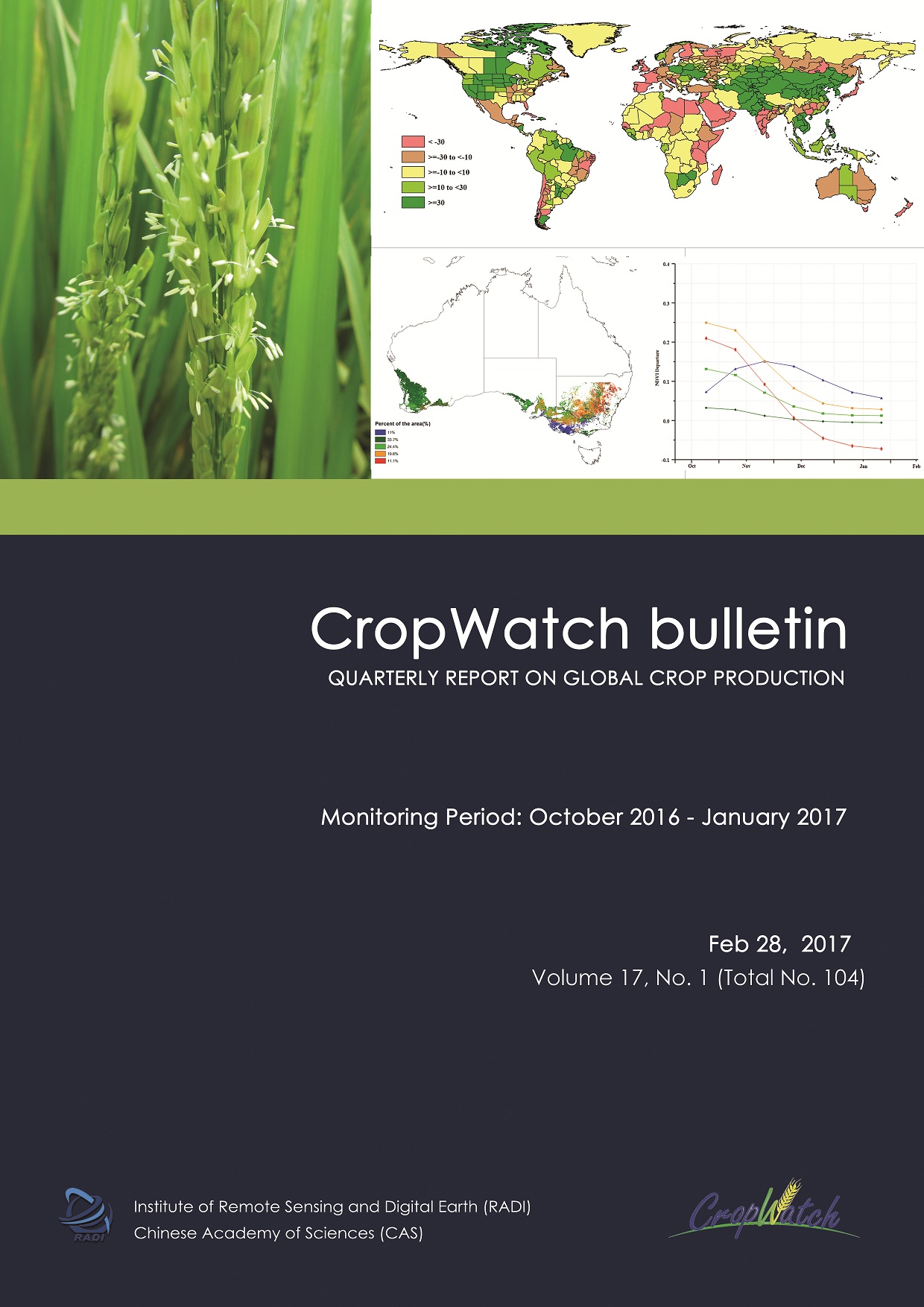
-
February 2017 CropWatch bulletin. The period from October 2016 to January 2017 is a relatively quiet period from an agricultural point of view. Nonetheless, this CropWatch bulletin presents updates on estimated 2016 wheat production in Argentina, Australia and Brazil. It also reports on recent disaster events, agriculture in East and Southeast Asia, and naturally on the condition of crops and other agroclimatic and agronomic indicators for China, globally important producers and exporters, and key regions important for agriculture.
Key messages from the report:
- Southern hemisphere production. Winter wheat harvesting here was completed. Estimates for main producers are: Argentina, 11.245 million tons (increase of 5.0% over last year); Australia, 32.066 million tons (up 24.3%); and Brazil, 7.747 million tons (+10.0%).
- Global environmental conditions. Several large areas displayed conditions that varied in a coherent fashion since last October, leading CropWatch to identify five relatively wet and ten relatively dry areas. Conditions and locations are described in Chapter 3.
- Snow cover. The area from eastern France to the Ural mountains generally recorded exceptional snow depths, especially from January
- China. China enjoyed crop conditions not unlike the previous season: TEMP was 0.7°C above average and RAIN was up 12%, combined with a drop in solar radiation (RADPAR, -12%). At the national level, CALF was stable with a bit of deceasing, and the overall expectations for the forthcoming winter wheat remain fair.
- Regions in China. CropWatch indicators point to favorable production prospects in the Loess region and Southwest China, although the latter also requires close monitoring, as adverse conditions could develop in specific areas. Close monitoring will also include Huanghuaihai and Lower Yangtze regions, as well as Southern China, which displayed below average crop condition throughout the monitoring period.
- Domestic prices. Prices in China will likely increase for rice, while decreases are projected for maize and wheat. For soybeans, wide fluctuations are conjectured.
- El Niño. EI Niño has continued to be neutral during the fourth quarter of 2016 and the start of 2017.
Introduction
This CropWatch bulletin summarizes global crop condition developments and agroclimatic factors from October 1 2016 to January 31 2017. Chapters 1 through 4 zoom in from a global overview of agroclimatic indicators (Chapter 1) to detailed descriptions of crop and environmental conditions in large production zones (Chapter 2), to individual country analyses covering 30 major producers and exporters (Chapter 3) and China (Chapter 4). A special focus section is included in Chapter 5, covering production outlook, disasters, East and Southeast Asia this time, and El Niño. This first part of the report includes the cover, table of contents, abbreviations, and a short overview of the different sections of the bulletin.DownloadChapter 1. Global agroclimatic patterns
Chapter 1 describes the CropWatch agroclimatic indicators for rainfall (RAIN), temperature (TEMP), and radiation (RADPAR), along with the agronomic indicator for potential biomass (BIOMSS) for sixty-five global Mapping and Reporting Units (MRU). Indicator values for all MRUs are provided in Annex A.DownloadChapter 2. Crop and environmental conditions in major production zones
Chapter 2 presents the same indicators—RAIN, TEMP, RADPAR, and BIOMSS—used in Chapter 1 and combines them with agronomic indicators—cropped arable land fraction (CALF), maximum vegetation condition index (VCIx), and minimum vegetation health index (VHIn)—to describe crop and environmental conditions in six global major production zones (MPZ). (See also Annex C for more information about these zones.)DownloadChapter 3. Main producing and exporting countries
Building on the global patterns presented in previous chapters, this chapter assesses the situation of crops in 30 key countries that represent the global major producers and exporters or otherwise are of global or CropWatch relevance. In addition, the overview section (3.1) pays attention to all countries worldwide, to provide some spatial and thematic detail to the overall features described in section 1.1. In section 3.2, the CropWatch monitored countries are presented, and for each country maps are included illustrating NDVI-based crop condition development graphs, maximum VCI, and spatial NDVI patterns with associated NDVI profiles. Additional information about the various indicators by country and 2016 wheat production estimates for Argentina, Australia, and Brazil are provided in Annexes A and B.DownloadChapter 4. China
Chapter 4 presents a detailed analysis for China, focusing on the seven most productive agro-ecological regions of the east and south: Northeast China, Inner Mongolia, Huanghuaihai, Loess region, Lower Yangtze, Southwest China, and Southern China. After a brief overview of the agroclimatic and agronomic conditions over the monitoring period (section 4.1), section 4.2 presents an update on domestic prices for major crops. The analysis for individual regions is provided in section 4.3. Additional information on the agroclimatic indicators for agriculturally important Chinese provinces are listed in table A.11 in Annex A.DownloadChapter 5. Focus and perspectives
Building on the CropWatch analyses presented in chapters 1 through 4, this chapter includes an updated production outlook for 2016 focused on wheat (section 5.1), as well as sections on recent disaster events (section 5.2), a focus on agriculture in the East and Southeast Asia (5.3) and an update on El Niño (5.4).DownloadAnnex A. Agroclimatic indicators
Tables in this Annex provide additional information about the agroclimatic indicators—RAIN, TEMP, and RADPAR—as well as BIOMSS for the various CropWatch spatial units. Those units include the Monitoring and Reporting Units (MRU); the thirty-one main producing and exporting countries; and regions or provinces within large countries—Argentina, Australia, Brazil, Canada, India, Kazakhstan, Russia, and the United States; and China.DownloadAnnex B. 2016-2017 Production estimates
Annex B includes tables with 2016-2017 production estimates for Argentina, Australia, and Brazil.DownloadAnnex C. Quick reference guide to CropWatch indicators, spatial units, and production estimation methodology
Annex C presents a brief overview of the CropWatch indicators and spatial units (including the MRUs, MPZs, and countries), along with a description of the CropWatch production estimation methodology.Download

